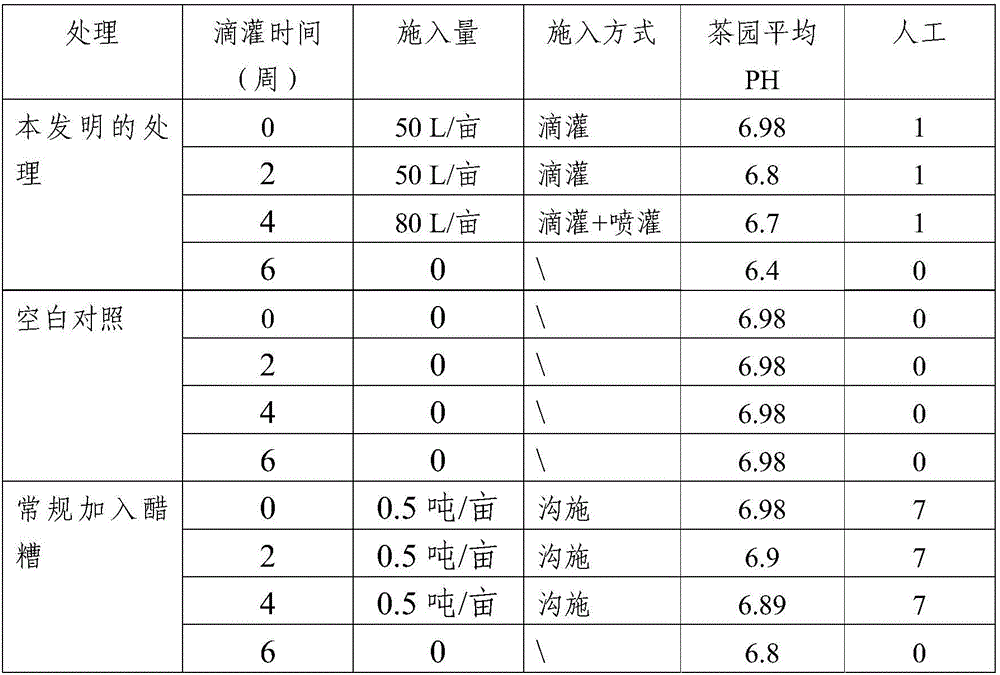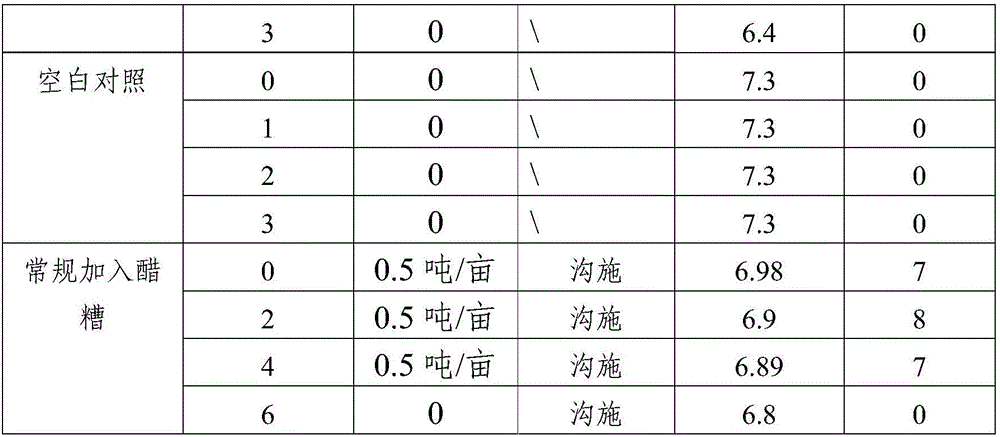Method for amending alkalescent tea garden by vinegar residue digested effluent
A technology of vinegar waste marsh and weak alkalinity, which is applied in the direction of soil preparation methods, chemical instruments and methods, and fertilizers made from biological wastes, and can solve problems such as irritating odor, polluted soil and groundwater, and environmental pollution around vinegar factories. , to achieve the effect of increased flexibility, labor saving and cost saving
- Summary
- Abstract
- Description
- Claims
- Application Information
AI Technical Summary
Problems solved by technology
Method used
Image
Examples
Embodiment 1
[0021] Embodiment 1 A method of improving weakly alkaline tea garden with vinegar residue biogas slurry
[0022] In 2015, the method of the present invention was implemented in the tea garden of Xiazhang Town, Tai'an. The tea tree species planted in the tea garden for the experiment is the Jiukengqun species.
[0023] A blank control (without any treatment) and a prior art control (adding vinegar grains in a conventional manner) are set. Carry out the processing of the present invention, specifically as follows:
[0024] Mix vinegar grains obtained from Tai'an Shankou Food Brewing Factory with water at a volume ratio of 1:1, put them in a fermenter for fermentation for 2 months, and obtain vinegar grains biogas slurry with a pH value of 5.5-6.0.
[0025] First measure the pH value of the tea garden soil, which is 6.98, and determine the drip irrigation frequency as drip irrigation with vinegar residue biogas slurry once every two weeks, and each drip irrigation is 50L / mu; by...
Embodiment 2
[0028] Embodiment 2 A method of improving weak alkaline tea garden with vinegar residue biogas slurry
[0029] Implement the method of the present invention in the tea garden of Jinan Changqing District in 2015. The tea tree varieties planted in the tea gardens for the experiment are Huangshan Group species.
[0030] A blank control (without any treatment) and a prior art control (adding vinegar grains in a conventional manner) are set. Carry out the processing of the present invention, specifically as follows:
[0031] Refer to Example 1 for the preparation of the acetic residue biogas slurry used.
[0032] First measure the pH value of the tea garden soil, which is 7.3, and determine the drip irrigation frequency to be drip irrigation of vinegar residue biogas slurry once a week, and each drip irrigation is 50L / mu. When the test was started, the growth of the tea tree was not good. Buds, at the interval of drip irrigation with vinegar residue biogas slurry, add water to d...
PUM
 Login to View More
Login to View More Abstract
Description
Claims
Application Information
 Login to View More
Login to View More - R&D
- Intellectual Property
- Life Sciences
- Materials
- Tech Scout
- Unparalleled Data Quality
- Higher Quality Content
- 60% Fewer Hallucinations
Browse by: Latest US Patents, China's latest patents, Technical Efficacy Thesaurus, Application Domain, Technology Topic, Popular Technical Reports.
© 2025 PatSnap. All rights reserved.Legal|Privacy policy|Modern Slavery Act Transparency Statement|Sitemap|About US| Contact US: help@patsnap.com



